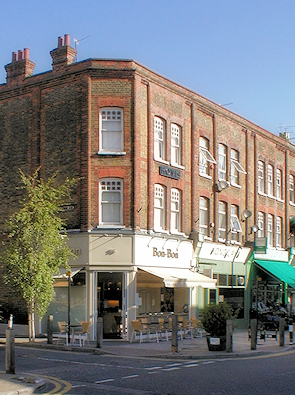Clapham Park
Clapham Park, Lambeth
Located in the south-east corner of Clapham, Clapham Park is a housing estate combined with an agreeable network of terraced streets that some prefer to call ‘Abbeville Village’ rather than part of Clapham Park

In 1825 Thomas Cubitt bought 229 acres of Bleak Hall Farm and began to lay out the Brixton side of the district as the Clapham Park estate, where he built his trademark Italianate villas, including a home for himself on Clarence Avenue. Development progressed slowly and it was not until the 1850s that most of the estate had been built up. By this time Clapham Park had become one of the most fashionable London addresses south of the river.
From the 1880s the previously undeveloped area near Clapham Common was laid out with streets of more compact housing, with Abbeville Road as the spine. Thomas Cubitt’s house was demolished in 1905 and the spacious semi-detached houses of Rodenhurst Road filled its grounds.
From 1929 to 1936 the London County Council laid out an estate of its standard neo-Georgian flats. The LCC resumed its programme after 1950, demolishing many of Cubitt’s houses and building low-rise shops and flats in a Swedish-influenced style. Lambeth council completed the scheme after 1965 in yet another style.
Problems of neglect caused social difficulties on the Clapham Park estate in the 1990s and these played a part in the decision to implement a transformative programme of rebuilding and refurbishment. The newly regenerated estate is now run by Clapham Park Homes, which is part of Metropolitan, a provider of integrated housing services. Its flagship structure is a swish new apartment block called the Cavendish Building.
Meanwhile, on Abbeville Road, the upmarket florists and trendy cafés tell the story of the enormous rise in popularity of what estate agents and local traders like to call Abbeville Village. Fortunately, the portmanteau ‘Abbevillage’ never caught on.
A third of Clapham Park’s population consists of black and minority ethnic groups. There is also a relatively high proportion of retired people and, on the Clapham Park estate, single-parent families.
Clapham Park was home to the piano manufacturer Whelpdale Maxwell and Codd until the company moved out in 2000 and subsequently ceased trading.
Postal district: SW4
Further reading: Joanna Bogle, One Corner of London: A History of St Bede’s, Clapham Park, Gracewing, 2003
Website: Clapham Park Project
